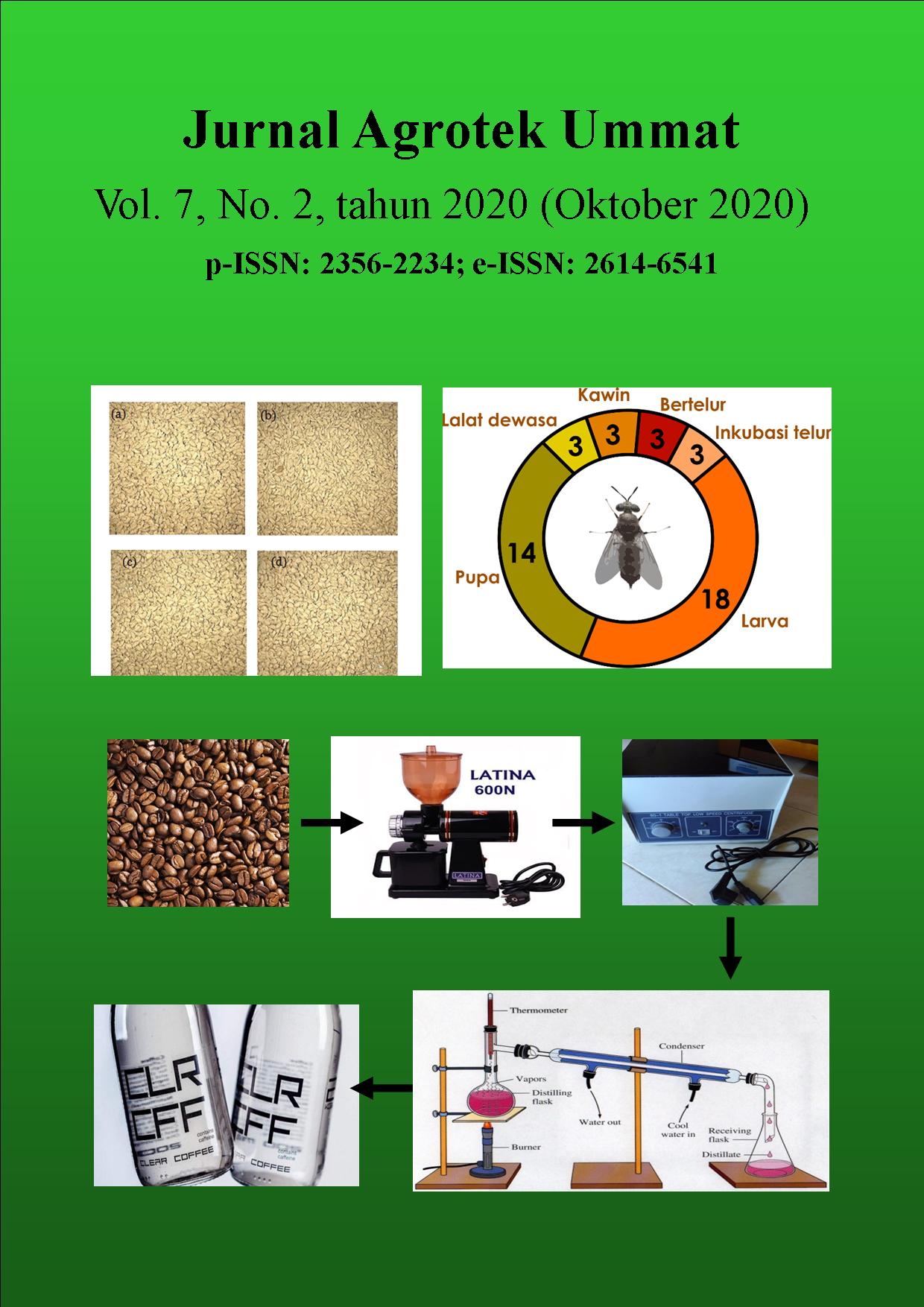ANALISIS KARAKTERISTIK KANDUNGAN KOPI BENING (CLEAR COFFEE) KABUPATEN BANYUWANGI
DOI:
https://doi.org/10.31764/jau.v7i2.2956Keywords:
Clear Coffee, Grinder, TemperatureAbstract
This research aims to find out the effect of preliminary treatment (roasted light roasting 190°C, medium roasting 195°C and dark roasting 200°C) and distillation method (water distillation and coffee extract) on the characteristics of clear coffee and provide benefits to know the characteristics of quality contained in the content of clear coffee. The method used is a distillation method that is carried out for 1 hour to be able to produce a clear copy that was previously done extras with the grinder Latina600N, Cloth Filter and Moka Pot and these results will be tested proximate and organoleptic test and then calculated variance analysis. The characterization of clear coffee in the testing of pH levels, protein content, moisture content, ash content, fat content, and caffeine content resulted that the dark roasting treatment (195°C-200°C) had the highest percentage value with low caffeine levels and roasting temperature treatment of 195°C-200°C had the highest favored level by using the commonly used Latina 600N grinder cafe-café coffee in general, and based on the results of roasting temperature variant 195°C-200°C has no noticeable effect with other temperature treatment as well as grinders used.References
Ahmad Ansori Mattjik, M. S. (2013) Perancangan percobaan dengan aplikasi SAS dan Minitab. PT Penerbit IPB Press.
Ana Farida, Evi Ristanti, A. C. K. (2013) ‘Coffee is one of the most famous beverages in the world . wor d . Coffee favored because it has unique taste and flavor . However , coffee contains excess acid and caffeine which has negative impacts on health . Fermentation is one of the alternative meth’, Jurnal Teknologi Kimia dan Industri, 2(3), pp. 70–75.
Hayati, R., Marliah, A. and Rosita, F. (2012) ‘Rita Hayati et al. (2012) J. Floratek 7: 66 - 75’, pp. 66–75.
Ilmiah, M. et al. (2017) ‘Pengaruh Penggunaan Getah Pepaya ( Carica papaya L . ) pada Proses Dekafeinasi Terhadap Penurunan Kadar Kafein Kopi Robusta’, 4(2), pp. 138–147.
Ir. Edy Panggabean (2011) Buku Pintar Kopi. Agromedia Pustaka, 2011.
Kusmiati, A. and Wati, N. S. (2017) ‘Kelayakan Finansial dan Sensitivitas Usahatani Kopi Robusta di Desa Kalibaru Manis Kecamatan Kalibaru Kabupaten Banyuwangi’, Journal of Chemical Information and Modeling, 8(9), pp. 1–58. doi: 10.1017/CBO9781107415324.004.
Marhaenanto, B., Soedibyo, D. W. and Farid, M. (2015) ‘Penentuan lama Sangrai Kopi Terhadap Variasi Derajat Sangrai’, Jurnal Agroteknologi, 09(02), pp. 1–10.
Novita, E. et al. (2010) ‘Peningkatan Mutu Biji Kopi Rakyat dengan Pengolahan Semi Basah Berbasis Produksi Bersih’, Agrotek, 4(1), pp. 76–90. doi: 10.1016/0165-1684(96)00046-1.
Nugraheni, K. S. et al. (2016) ‘Pengaruh Perlakuan Pendahuluan Dan Variasi Metode Destilasi Terhadap Karakteristik Mutu Minyak Atsiri Daun Kayu Manis (C. Burmanii)’, Jurnal Teknologi Hasil Pertanian, IX(2), pp. 51–64.
Pohl, P. et al. (2013) ‘Determination of the Elemental Composition of Coffee Using Instrumental Methods’, Food Analytical Methods, 6(2), pp. 598–613. doi: 10.1007/s12161-012-9467-6.
Praseptiangga, D., Aviany, T. P. and Parnanto, N. H. R. (2016) ‘PENGARUH PENAMBAHAN GUM ARAB TERHADAP KARAKTERISTIK FISIKOKIMIA DAN SENSORIS FRUIT LEATHER NANGKA (Artocarpus heterophyllus)’, Jurnal Teknologi Hasil Pertanian, 9(1), pp. 71–83. doi: 10.20961/jthp.v9i2.12858.
R. J. Clarke, O. G. V. (2001) ‘Coffee Recent Developements’, pp. 18–32.
Raharjo, P. (2012) Panduan Budidaya danPengolahan Kopi Arabika dan Robusta. Penebaran Swadaya.Jakarta.
Susilowati, S. H. (2008) ‘Agricultural-Demand-Led-Industrialization Strategy In The Perspective Of Economic Performance Improvement And Farmer ’ s Income’, 26(1), pp. 44–57.
Wijaya, D. A. and Yuwono, S. S. (2015) ‘PENGARUH LAMA PENGUKUSAN DAN KONSENTRASI ETIL ASETAT TERHADAP KARAKTERISTIK KOPI PADA PROSES DEKAFEINASI KOPI ROBUSTA Effect of Steaming Time and Ethyl Acetate Concentration against Characteristics of Coffee In Process Robusta Coffee Decaffeination’, 3(4), pp. 1560–1566.
Downloads
Published
Issue
Section
License
Authors who publish articles in Jurnal Agrotek Ummatagree to the following terms:- Authors retain copyright of the article and grant the journal right of first publication with the work simultaneously licensed under a CC-BY-SA or The Creative Commons Attribution–ShareAlike License.
- Authors are able to enter into separate, additional contractual arrangements for the non-exclusive distribution of the journal's published version of the work (e.g., post it to an institutional repository or publish it in a book), with an acknowledgment of its initial publication in this journal.
- Authors are permitted and encouraged to post their work online (e.g., in institutional repositories or on their website) prior to and during the submission process, as it can lead to productive exchanges, as well as earlier and greater citation of published work (See The Effect of Open Access).

